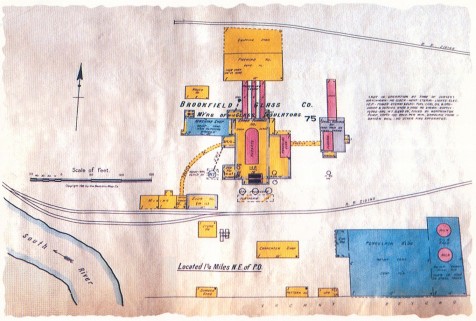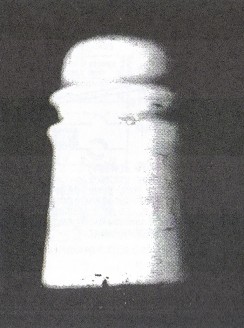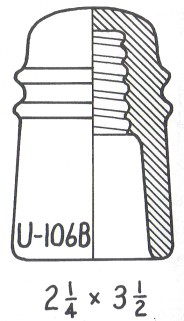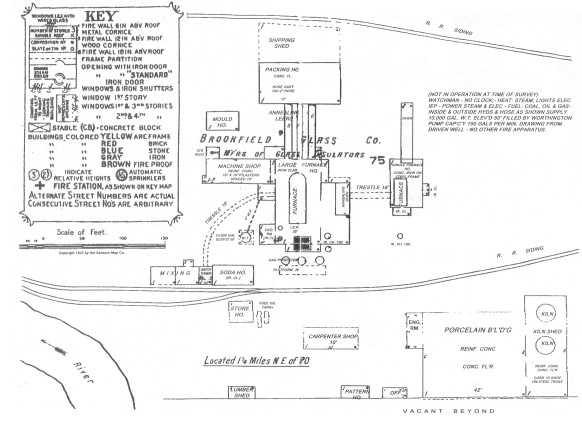The Map of the "Missing Link" Brookfield Porcelain
by Dave Sztramski
Reprinted from "Crown Jewels of the Wire", November 1998, page 6
As many of you already know, I have been scratching around the Brookfield
factory site for a couple of years now. I began collecting only about five years
ago and had a general collection. The more I dug at the factory, the more I
appreciated Brookfields. Now, my collection is mostly Brookfield, in particular,
skirt embossed or unembossed types made in Old Bridge from around the
turn-of-the-century
until 1920.
As my interest in the factory grew, I became ravenous for more
historical information. I searched for photographs in the form of postcards (see
Crown Jewels, January 1996). I visited local museums, libraries, universities
and even the Smithsonian Institute in Washington, D.C. I phoned the Corning
Glass Museum and industrial museums, however, I found no additional information.
That is until I visited the New Jersey State Library in Trenton, New Jersey. I
knew that Sanborn fire insurance maps existed and I hoped at least one in their
collection would show Brookfield. I viewed microfilm and found a map from 1922.
But...wait a minute! What does that say?! PORCELAIN building?!! I didn't know
Brookfield made porcelain. But, there it was. A building clearly marked as such.
This was good stuff!
I dropped my quarters into a machine with a built-in
photocopier, but the result left a lot to be desired. The microfilm was black
and white. The shading of the building on the original appeared dark. As a
result, the copy was even darker making the labeling illegible.
I spoke to the
librarian about originals. He was a nice man, but said their collection was very
limited. Oh, well, back to the machine to try more copies. I was also looking
for other Jersey insulator companies --- Gayner, Whitall Tatum, Sterling, Novelty
and other glass houses which may have produced insulators. There may have been
porcelain manufacturers as well.
I was just about done when in came the
librarian carrying a thick book of maps, approximately 2-1/2 by 3 feet. He said,
"I only pull off one miracle a week." We opened the book to Old Bridge
and there it was. A map from 1922 depicting the Brookfield Glass Company. The
great part? The map was in color. I was able to photocopy it with the permission
of the librarian. The copies came out much better. Once I realized the map was
so colorful, I knew I had to return with a 35mm camera to capture it on film.
Before I left, I looked through books for related material. I found an
industrial directory for New Jersey, and dating from 1918. This directory listed the Brookfield Glass Company:
manufacturer of glass and porcelain, employing 200 people. Brookfield did make
porcelain!!!!!

(Cover Photo)
I returned to the library two days later with a camera and tripod
in tow. I shot an entire roll of film to include one of the pictures you see
on this month's cover.
On the next trip to the plant site, I was armed with a
map and three good photos from postcards of the factory. It was really neat to
put a name to the face or be able to identify individual buildings in the
pictures. I oriented the map with the river and the direction in which the
tracks once came. I was able to determine that the only part of the facility not
covered by apartments was, in fact, the porcelain building, or what was left of
the building -- a slab of concrete the same size of that shown on the map.
In
February, 1998, Carol McDougald interviewed William Brookfield who, as a boy,
often visited the plant with his father, Henry Brookfield. Mr. Brookfield
remembered the building and said it was a "...fine building with brick
kilns." He also stated that several batches of porcelain insulators,
perhaps three or four thousand, were produced shortly before the plant closed in
1922. Unfortunately, he could not recall shapes or glaze colors.
After finding
the map, I always kept my eyes open for porcelain shards but never found one.
That is, until this spring when I went down to dig in the woods near the
porcelain building, as I had done so many times before. But what did I see? No
more trees! They had ripped out the woods to build more apartments. The
bulldozers were very unforgiving. I found very few whole or undamaged
insulators. I did find some common insulators - none solid pour, some factory
rejects and just a few crumbs (and I mean crumbs) of rare insulators. I found the
dome to a porcelain signal with a butterscotch glaze.
A couple of months before
the National, I was joined at the plant by a collector friend to walk the site.
We walked slowly, he looking left while I, ten paces behind, looked right. I
picked up what, at first, I thought was a milk glass toll. It turned out to be a
dry process porcelain toll embossed AM. TEL & TEL CO. in raised letters with
a white glazing. I am by no means a porcelain expert, so I didn't even know what
I had found. However, my collector friend, a collector of over 25 years, said,
"Far out, a new U-number!"
We returned to my home where, once again, I
phoned Elton Gish, who had never heard of anything like it. He told me porcelain
shrinks 15-17% when fired. The new find appeared to be about 15% smaller than a
glass CD 121 AM. TEL & TEL CO. toll. I speculated perhaps Brookfield formed
it in a glass mold(?).
 |
 |
|
Embossed AM. TEL & TEL CO. white porcelain U-I06B. |
My girlfriend Candy and I had a great time at the
National in Williamsburg this summer. We saw old friends, met a lot of new
friends were able to talk, in person, to many friends we know only by telephone. One
of the many highlights for me was sharing my new finds with all of them.
I
brought the two porcelain pieces to Elton at the show. He thought the
butterscotch glazed signal dome might be a Pittsburg. He could not attribute the
little white toll to any manufacturer. Elton made shadow drawings and
photographed the toll. He has since assigned it a number, U-106B.
Since my find
of the U-106B this spring, two new apartment buildings have sprung up in the
immediate area of the porcelain building. Rather than rip up the slab of the
porcelain building and excavate the usual crawlspace-type foundations, the
developer has opted to build the new buildings with a slab on grade foundation
and backfill the area with three or four feet of dirt, forever denying anyone
the opportunity to search any further. Oh well, all good things come to an end.
Did Brookfield make porcelain insulators? I believe so -- at least in limited
numbers. AM. TEL & TEL CO. was one of their major customers. Perhaps the U-106B was a porcelain sample.
I would like to think the U-106B toll is the
"missing link" between Brookfield glass and porcelain insulators. I
now fantasize about the Brookfield/New York or B embossing on insulators with
wild colorful glazes.

Medium Image (130 Kb)
Large Image (315 Kb)
| 